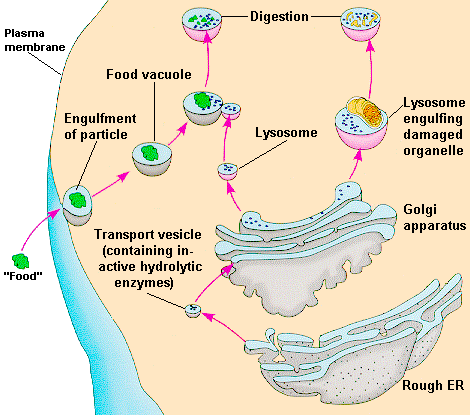lysosome

Lysosome structure and function.
A lysosome is a membrane-bounded organelle, found in the cytoplasm of eukaryotic cells, which contains digestive enzymes. It acts as the "garbage disposal" of the cell by breaking down cell components that are no longer needed as well as molecules or even bacteria that are ingested by the cell. The interior of a lysosome is strongly acidic, and its enzymes are active at an acid pH. Lysosomes are found in all eukaryotic cells, but are most numerous in disease-fighting cells, such as leukocytes (white blood cells).
Some human diseases are caused by lysosome enzyme disorders. Tay-Sachs disease, for example, is caused by a genetic defect that prevents the formation of an essential enzyme that breaks down ganglioside lipids. An accumulation of undigested ganglioside damages the nervous system, causing mental retardation and death in early childhood.
Details of function and structure
Lysosomes break down cellular waste products, fats, carbohydrates, proteins, and other macromolecules into simple compounds, which are then returned to the cytoplasm as new cell-building materials. To accomplish the tasks associated with digestion, the lysosomes use some 40 different types of hydrolytic enzymes, all of which are manufactured in the endoplasmic reticulum and modified in the Golgi apparatus. Lysosomes are often budded from the membrane of the Golgi apparatus, but in some cases they develop gradually from late endosomes, which are vesicles that carry materials brought into the cell by a process known as endocytosis.
Like other microbodies, lysosomes are spherical organelles contained by a single layer membrane, though their size and shape varies to some extent. This membrane protects the rest of the cell from the digestive enzymes contained in the lysosomes, which would otherwise cause significant damage. The cell is further safeguarded from exposure to the biochemical catalysts present in lysosomes by their dependency on an acidic environment. With an average pH of about 4.8, the lysosomal matrix is favorable for enzymatic activity, but the neutral environment of the cytosol renders most of the digestive enzymes inoperative, so even if a lysosome is ruptured, the cell as a whole may remain uninjured. The acidity of the lysosome is maintained with the help of hydrogen ion pumps, and the organelle avoids self-digestion by glucosylation of inner membrane proteins to prevent their degradation.


